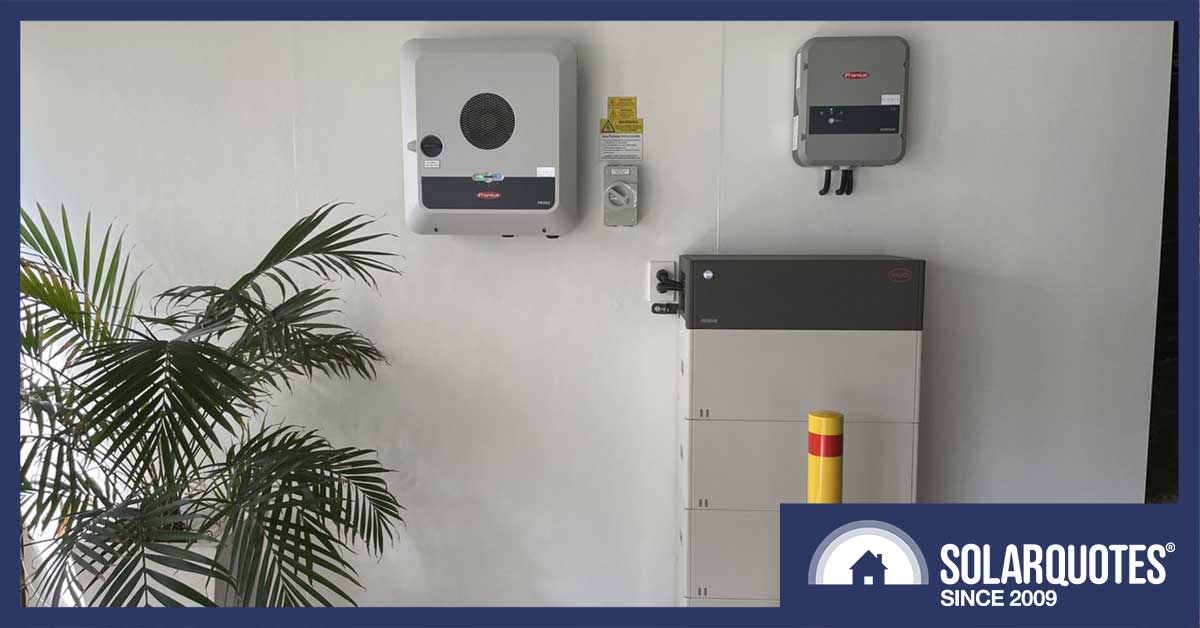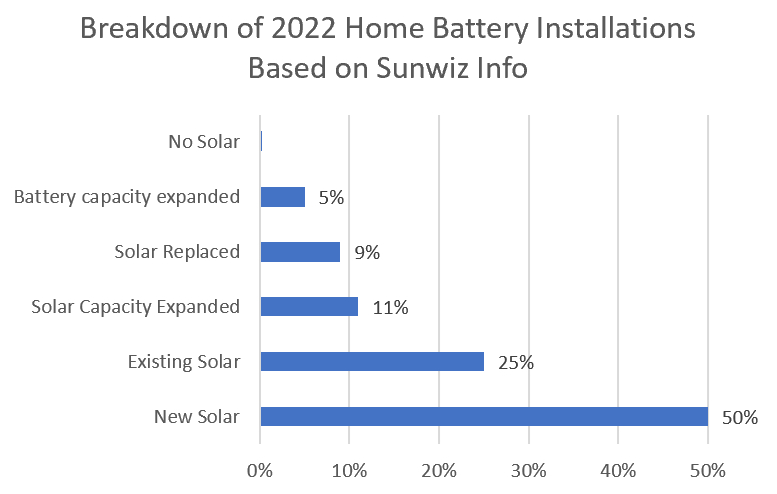
Installation by DJM Electrical
This year’s Smart Energy Conference was abuzz with news on solar and batteries — more abuzz than a bucket of Queensland prawns on a hot tin roof. The hottest of hot topics was home batteries — not because dodgy ones were spouting flame — but because their installation rate is soaring. If growth continues, by the end of 2027, Australia could have as many home batteries as some optimists predicted for the year 2020.
An excellent source of battery information is Warick Johnston, Managing Director of Sunwiz.
Sunwiz is a solar consultancy company that does loads of market research, including on batteries. They’ve given us interesting information in the past, and that is appreciated. Warwick Johnston has been in the solar industry for 18 years. Long enough for us to give him the nickname “Warwick-san” on account of how he’s not Japanese. (It’s like how we call people with red hair “Blue”.) He spoke at the Smart Energy Conference, and I’ll tell you the major points he made on home battery uptake. While it wasn’t too far from what I expected, some points surprised me.
I didn’t attend the talk in person, but neither did he, so we’re even. He appeared in video form. He wasn’t there in person due to family health reasons. I guess he must be one of “those” sorts. You know — people who love their family.
50% Growth In Residential Batteries
The big news is how battery installations are finally taking off, years after battery optimists thought they would. Around 47,100 home batteries were installed last year. That’s an increase of 50% from 2021. Commercial battery installations were also up. The only area that saw a decline was utility-scale batteries. Australia leads the world in building big batteries, so it may seem strange fewer megawatt-hours were added last year than the one before. But because they’re so big, there’s a lot of lumpiness in how much capacity is added each year, so it’s not unexpected.
South Australia is the state with the highest portion of battery households. There are several reasons, but the main one is the state’s generous battery subsidy that ended in July last year. By my calculations, around 1 in 60 South Australian homes has a battery. That’s 1.7%.
Home Battery Installations By Type
Warwick-san divided last year’s home battery installations into six categories. From the largest percentage of installations to the smallest, they were…
- 50% — A battery and solar system installed on a home without existing solar.
- 25% — A battery installed at a home with existing solar.
- 11% — A battery installed and the existing solar capacity was upgraded.
- 9% — A new battery installed and the existing solar system was replaced.
- 5% — Existing battery capacity at the site was expanded.
- A “handful” were installed in homes without existing solar or solar being added.
I don’t want to reproduce any of Warwick’s graphs because Sunwiz puts a lot of work into them and uses them to help sell reports to earn a crust. Or maybe even two crusts. But if I make a crappy graph of my own, hopefully no one will be upset:

My Thoughts
I’m a little surprised that 50% of batteries were installed along with a new solar system on a roof that was previously solar-free.
I suspect many people buying a brand new battery and solar simultaneously looked at the return from both blended together and decided it was a good deal. If they had looked at the excellent return from just getting solar and compared it to the much lower return from solar and a battery, I expect some would have decided to put off buying a battery for now.
Expanding Existing Solar Can Be Difficult
Warwick-san said in 11% of battery installs existing solar capacity was upgraded. There are two main ways to do this:
- Add more solar panels to an existing solar system.
- Install a second separate solar system on the roof.
While he sounded like he was referring to only the first category, I’m sure at least some people would have had a second solar system installed. As they’re not mentioned elsewhere, I assume they’re included in this category.
One reason a homeowner buying a battery may want to install a second solar system is some battery systems are limited in the size of the solar system they can be connected to. To have the desired total solar panel capacity on the roof, two separate systems can be necessary.
Scrapping Your Old Solar
Around 9% of the time, a battery was installed, an old solar system was ripped off the roof and replaced with a new one. It can make a lot of sense to replace a small old system with a larger new one that has higher efficiency panels and a fresh set of warranties. It may make sense even if the solar system isn’t that old.
If you ask me how much solar you should install, my advice is to fill your roof! Or at least install as much as will reasonably fit. This is a good idea if you don’t have a battery, and if you do, it will help keep it charged on cloudy days and in the middle of winter. It will also mean you’ll be ready for when you get an electric car — or a second or third one.
Expanding Battery Capacity
In 5% of cases, what was called a “battery installation” actually involved increasing the capacity of an existing battery system. If you want to expand your battery capacity, go for it. But my advice is to try to avoid the need by selecting a suitable amount of storage capacity in the first place. If you have money to spare and aren’t certain how much storage capacity you want, there’s no real point in getting a small battery and possibly regretting it later. But if you can only afford a small battery, unless you’re confident it makes sense for you, I recommend thinking hard about if you can really afford a battery at all at this time.
Batteries Without Solar
A “handful” of batteries were installed in homes with no solar. While this may seem strange, a solar-less home battery may be able to pay for itself under the right circumstances. But I suspect the main reason people want them is for backup.
While the user manuals of battery systems normally say they can’t be relied on to power life support equipment, if I were on life support, I’d want a home battery. As well as a separate Uninterruptible Power Supply (UPS) in case one didn’t work. I’d want a generator too, because who knows how long a blackout might last?
Of course, if I’m on life support, I will have trouble testing the generator and following its maintenance schedule, so I might need some sort of robot. Elon Musk says he’ll have one ready next year, so, translated into normal human English, that means about 20 years from now… Goddammit! It looks like I will have to love my family too!
Battery Trends
One battery trend mentioned by Warwick that we’re currently seeing all over the place is the shift towards the unification of batteries and inverters. This is where the battery and inverter come from the same company. This is useful because it means the hardware is (almost) certain to work well together. It eliminates finger-pointing where a battery manufacturer blames the inverter for a problem and vice versa.
Another thing he mentioned is a considerable number of battery manufacturers sell under 2,000 units a year, and many of them are likely to exit the Australian market.
Warwick-san advised installers not to act as though they’ll only see their customers once. He didn’t say this because batteries are still so unreliable they’ll be around a dozen or more times to fix them. He instead meant there can be multiple opportunities to sell to one customer. One household may want solar, then a battery, then expanded solar capacity, followed by expanded battery capacity, then an EV charger, etc.
Batteries Will Be Big
I don’t doubt home batteries will play a much larger role in the future than they do now. This is because:
- Lithium and other materials used to make them are falling in price.
- While solar feed-in tariffs will rise in the National Electricity Market1 next financial year; after that, they’re likely to start heading down and this will improve the financial return from batteries.
- Homes will consume more electrical energy as natural gas consumption is gradually eliminated and road transport goes electric.
- Battery technology will continue to improve in reliability and affordability.
While batteries will be cheaper in future, I don’t know when they’ll fall in price. So if you want a battery and buying one won’t cause financial hardship, go get one. Even if it’s not a money maker, it can provide backup power and is good for the environment because it can store clean energy that otherwise may go to waste.
Footnotes
- The NEM does not include WA, NT, or WTF. ↩
